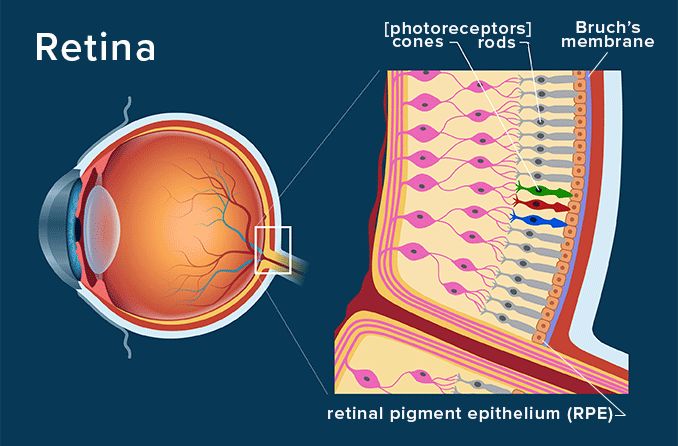Angioid streaks

What are angioid streaks?
Angioid streaks are jagged lines visible on the retina (the light-sensitive tissue in the back of the eyeball). They can only be seen by an eye doctor when they look inside the eye during an eye exam. Angioid streaks typically have no symptoms. But they can sometimes lead to complications that can decrease vision.
A person with angioid streaks will have them in both eyes. When an eye doctor looks at the retina during an eye exam, these streaks appear as orange, red, gray or brown colored lines radiating out from the optic disc. Due to this, doctors often describe them as resembling blood vessels.
Angioid streak causes
Angioid streaks are caused by cracks in a structure called Bruch’s membrane. Bruch’s membrane is a thin structure between the retina and the choroid (the blood vessel layer of the eye). It acts as a filter and helps to regulate the nutrients and waste passing between these layers.
Breaks in Bruch’s membrane are typically due to the thickening and calcification of the membrane. They can also occur spontaneously in some individuals. An injury may cause these breaks to worsen.
Risk factors
Connective tissue disease is the cause of about half of the cases of angioid streaks. These diseases affect the tissue that connects and supports the body. The other half of angioid streak cases are considered idiopathic (without a known cause).
Connective tissue diseases
Some connective tissue diseases that are commonly associated with angioid streaks include:
Pseudoxanthoma elasticum (PXE) – This condition causes minerals such as calcium to accumulate in the body’s elastic tissue, including in Bruch’s membrane. It can cause a number of issues in a person’s skin, eyes and blood vessels. Angioid streaks have been noted in 80% to 87% of all people with PXE.
Paget’s disease of bone – This disease causes abnormalities in the normal process of bone tissue breakdown, repair and regrowth, leading to bone deformation and fragile bones. It typically only affects a few bones. Symptoms are not common but may be similar to arthritis pain. Angioid streaks affect around 2% to 12% of people with Paget’s.
Sickle cell hemoglobinopathies – This group of inheritable diseases affects the body’s red blood cells. Angioid streaks become more common with age in people with sickle cell hemoglobinopathies. Angioid streaks only occur in about 1.5 % of younger individuals, while 22% of individuals over the age of 55 have them.
In the past, Ehler-Danlos syndrome was also thought to have a high association. But recent studies have shown that angioid streaks occur in less than 1% of individuals with this syndrome.
Age
Angioid streaks most commonly appear when individuals are in their mid-50s. If an individual has an associated disease, angioid streaks could appear while they are younger.
Injury
Individuals who have been diagnosed with angioid streaks are more likely to develop a rupture in the choroid layer of the eye. These individuals should always wear eye protection during sports and other physical activities.
Potential complications of angioid streaks
While angioid streaks are usually asymptomatic, they can result in secondary complications.
Choroidal neovascularization (CNV)
A common and serious complication is choroidal neovascularization (CNV). CNV is the growth of new and abnormal blood vessels into the eye’s retinal layer.
These new blood vessels are called choroidal neovascular membranes (CNVM), which are fragile and leaky.
CNVMs can grow through the cracks in Bruch’s membrane and into the retina. Blood and fluid from these weak blood vessels can leak onto the retina and damage it.
Symptoms of CNV include:
Painless loss of vision which may appear as blank spots in central vision
Distorted vision
Objects appear to have a different size in each eye
Colors appear less bright or have different hues in each eye
Approximately 40 to 80% of individuals with PXE who have angioid streaks develop choroidal neovascularization, so they must be monitored carefully. This complication can involve both eyes but often affects only one eye.
Involvement of the fovea
Another potential complication of angioid streaks is foveal involvement. The fovea is located on the retina and is responsible for detailed, central vision. This is the vision used in tasks like reading this article.
If Bruch’s membrane ruptures near the fovea, bleeding under the retina — a subretinal hemorrhage — can occur and can cause loss or distortion of vision.
When to see a doctor
You should schedule an appointment with an eye doctor if you’ve recently been diagnosed with a disease associated with angioid streaks.
Although angioid streaks do not usually have visual symptoms, vision loss can occur due to secondary complications. If you notice blurry vision, distorted vision, flashes or flickering of light in your central vision, or a difference in image color or brightness between the eyes, contact your doctor immediately.
Angioid streaks. StatPearls. July 2022.
Angioid streaks. American Academy of Ophthalmology. September 2022.
The dynamic nature of Bruch’s membrane. Progression Retinal and Eye Research. January 2010.
Pseudoxanthoma elasticum. National Organization of Rare Disorders. September 2022.
Paget’s disease of bone. Mayo Clinic. September 2022.
Streaks of concern. Review of Optometry. January 2018.
Angioid streaks: fundoscopic analysis of 317 cases. Brazilian Council of Ophthalmology. December 2008.
Choroidal neovascularization: mechanisms of endothelial dysfunction. Frontiers in Pharmacology. November 2019.
What are choroidal neovascular membranes? American Academy of Ophthalmology. December 2021.
What is choroidal neovascularization? BrightFocus Foundation. July 2021.
Anatomy, head and neck, eye fovea. StatPearls. July 2021.
Page published on Tuesday, October 4, 2022






